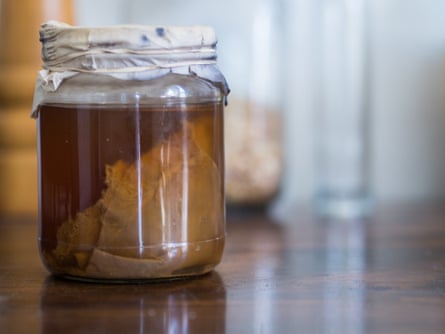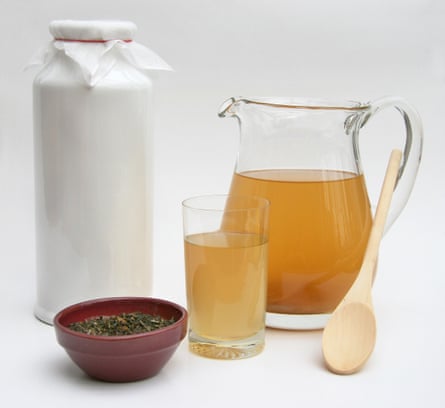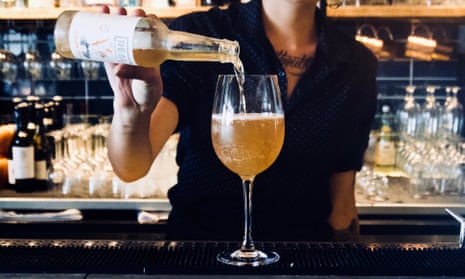When I was a child, homebrew meant the beer my grandad produced under his stairs. Come Christmas, my father and uncles would congregate there, holding up cloudy beer mugs to the light and nodding appreciatively.
The Guardian’s product and service reviews are independent and are in no way influenced by any advertiser or commercial initiative. We will earn a commission from the retailer if you buy something through an affiliate link. Learn more.
Increasingly, however, home brewers are knocking out kombucha instead – a traditional, non-alcoholic drink made with fermented tea.
Take Jonny Wilkinson, one of England’s best-loved rugby stars. Rugby types may be better known as prolific beer drinkers, but Wilkinson has been brewing his own kombucha for four years. He says introducing fermented items into his diet has brought “a lightness, less conflict in my gut and a more alert, flowing nature to everything”. In May, he launched his own brand, No1 Kombucha, in Sainsbury’s with the intention of bringing the naturally fizzy soft drink to the masses.
He is not the only one on such a mission. The fast-food chain Leon now stocks Suffolk-brewed kombucha from LA Brewery, while another British brand, Real Kombucha, will soon be rolled out in 320 Fuller’s pubs. In less than a year, Real Kombucha has reached “almost 50 Michelin-starred restaurants, almost 300 top hotels and 55 Laines pubs”, according to its founder, David Begg.
The drink’s leap from health stores to the mainstream via hipster cafes has been swift. LA Kombucha’s founder, Louise Avery, was partly responsible for the drink’s graduation in the UK from murky cult endeavour to cafe culture. She began by brewing it at home under the brand Lois & the Living Teas. “About five years ago, I started bringing up these cloudy milk bottles of kombucha to beautiful cafes around Islington and Hackney in London and they would strain it and serve it to customers.” It flew off the shelves, word spread and Yauatcha, a dim sum restaurant in Soho, came knocking.
Many of these cafe owners had come to London from abroad – Germany, Australia, Canada – and were already familiar with kombucha. Avery says British proprietors were more sceptical, “because there’d be bits floating in it, like yeast; people were a bit scared and disgusted. I had to explain it’s a live food and it will continue to grow.” In response, she took steps to make her product more palatable to mass-market consumers. “I figured out a way of mildly filtering it and adding a bit of carbonation to suspend the bacteria; I make sure it’s chilled and I give it a short shelf life to keep as much bacteria as I can without it being an explosive product with bits floating in it.”
It worked. When LA Kombucha launched in June, Avery sold 2,000 bottles. The next month, sales rose to 10,000; within six months, Leon had signed up and she had to build a second brewery.
Promising scientific findings into how our gut affects everything from mental health to autoimmune disease have boosted demand for so-called gut-healthy fermented products such as kefir (a yoghurt drink), kimchi (Korean-style fermented cabbage) and kombucha, which probably originated in China.
The brewing process for kombucha is relatively simple. Tea (either green, black or a mix of both), sugar and filtered water are sealed with a slimy-looking cellulose mat called a Scoby (this stands for “symbiotic culture of bacteria and yeast”). Scobys, which you can buy on eBay, are produced naturally by bacteria and contain the necessary micro-organisms to kick off kombucha fermentation. You float this biofilm on your mixture and let it brew for between seven and 30 days, depending on atmospheric conditions and personal taste. The tea itself ferments, while the yeasts turn the sugar into alcohol, which the bacteria converts into acetic acid, making carbon dioxide bubbles in the process. The longer it brews, the less sweet and more vinegary it becomes.

Kombucha’s twangy taste can be enhanced by adding fruits and spices, and most commercial offerings do this. LA Brewery’s ginger variety is satisfyingly fiery, like a traditional ginger beer with a dash of lemonade and the complex pungent, pickle taste you get with kombucha. No1’s passionfruit and goji is fruity and refreshing. Like LA Brewery and No1, Real Kombucha also comes in three choices, although none of these have added flavours – the differences come from the types of tea used. But all three producers carefully avoid making specific health claims, instead promoting the sensory experience of their drinks as something to be appreciated by connoisseurs.
Why not push the health angle? Because, says, Paul Humphreys, professor of applied microbiology at the University of Huddersfield, “all the data is either anecdotal or from animal studies. There are a couple of rat studies around cholesterol and hypertension that show potential.” The only human clinical case studies published, he says, tend to be one-off events with negative effects such as people getting acidosis – when there’s too much acid in the body – possibly from drinking too much kombucha.
Part of kombucha’s appeal is its live-bacteria element, but the jury is out on how beneficial the microbes in the drink are. Humphreys says there aren’t many “classic probiotic bacteria in it at all. Not the lactobacillus or bifidobacteria, which are the dairy probiotics. You get reports of people finding them in kombucha, but nowhere near what you’d find in some yoghurts or kefir.” That’s not to say that kombucha bacteria aren’t doing good – we just don’t know. And being a wild fermented drink, the yeast and bacteria profiles fluctuate.
Humphreys brews his own kombucha at home as an alternative to soft drinks and alcohol. A number of brands have sent their products to his lab for analysis but, he says: “I would never make any health claims based on what we’ve found. I wouldn’t even infer them. It’s such a complicated product.” He prefers his kombucha sour and believes the commercial versions leave in more sugar than you would find in the traditional drink. “It’s lost in the mists of time, but these fermentations were originally about making water safe to drink, so they were probably quite acidic.”
Being big on yeast, however, the drink does offer B vitamins, which could be beneficial if you’re deficient. It also contains some vitamin C. And there are polyphenols – plant micronutrients that are antioxidant-rich and feed the good bacteria in your gut. These come from the tea itself, but could be more beneficial in kombucha than in a regular cuppa.

Whether the microbiological benefits can be proven or not, there is the undeniable advantage that commercial kombuchas often contain less than one third (or less than half with No1) of the sugar of regular soft drinks, and no artificial sweeteners. And if they help heavy drinkers cut down on alcohol consumption, there’s another win. This is precisely what Begg is hoping, as Real Kombucha hits pubs and bars up and down the UK. “We approached it entirely as an alcohol replacement,” he says. “We are in the space of champagne, wine, craft beer.”
Rather than compare his products with soft drinks, Begg places them “somewhere between a fruity prosecco or a lighter dry cider”. Sommeliers have been enlisted to proffer food-pairing tips. The young leaves of “first flush” Darjeeling tea, used in his Royal Flush kombucha, produce notes of raspberry, rhubarb, blackcurrant and, he says, “a little bit of white peach, in the flavour profile”. It’s certainly interesting and strong enough to be sipped, occupying your senses as much any alcoholic beverage.
Another in the range is called Smokehouse because the black tea from the hills of southern China tastes a little smoky, but the apple and caramel flavours it produces mean people associate it with cider. The only things missing, says Begg, “are the legs or potency of alcohol, but Royal Flush does even have a slightly puckering astringency in the background”.
In the US – where sales of kombucha and other fermented drinks were up by 37% in 2017, while the rest of the soft drink market barely grew – it has also become a popular mixer for cocktails. Food website Bon Appetit published recipes for kombucha cocktails that, it said “prove kombucha and booze are made for each other”. Food blog Chowhound offered: “13 kombucha cocktails to jazz up your bartending game.” Not surprisingly, kombucha now sits in the fridges of some of the UK’s top mixologists.
Begg’s first encounter with kombucha was a friend’s home brew, and it immediately satisfied the craving for alcohol he had been experiencing. He had largely given up booze, but didn’t want sweet soft drinks or water when he went out socially. Avery agrees: “Alcohol plays on a number of receptors and kombucha has that, too. Umami, sour, sweetness; you have the fizziness and viscosity that sits on your tongue.” Whether pubgoers will order it instead of booze is yet to be seen, but, says Begg: “We’ve done it in restaurants – expanding well across the upper end as a wine replacement. Now, we’re saying the pub is the next bastion.”

Comments (…)
Sign in or create your Guardian account to join the discussion